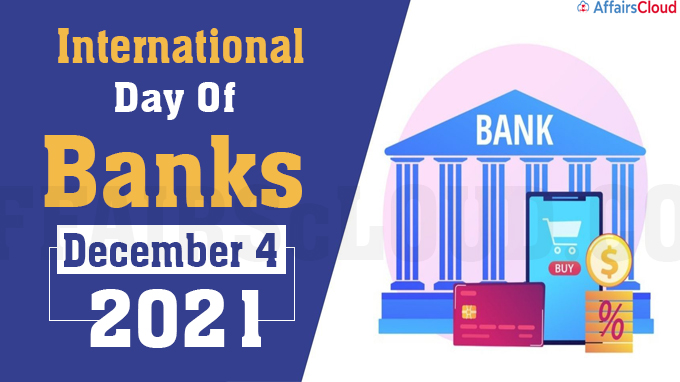
The United Nations(UN)’s International Day of Banks is annually observed across the globe on 4th December to recognise the vital role of the banking systems in the UN Member States in contributing to the improvement of their standard of living.
The day also recognises the potential of multilateral development banks and other international development banks in financing sustainable development.
- 4th December 2021 marks the observance of the 2nd International Day of Banks.
Background:
i.The United Nations General Assembly(UNGA) adopted the resolution A/RES/74/245 on 19th December 2019 and proclaimed the 4th December of every year as the International Day of Banks.
ii.The first ever International Day of Banks was observed on 4th December 2020.
Addis Ababa Action Agenda:
i.The Addis Ababa Action Agenda was the outcome of the 2015 Third International Conference on Financing for Development, held in Addis Ababa, Ethiopia.
ii.It provides a framework for effective mobilization of resources at national and international level for sustainable development
iii.This also supports the implementation of the Sustainable Development Goals(SDGs).
New banking reforms in India:
In May 2021, the Government of India announced new banking reforms to ease its burden in terms of mobilising additional capital. The reform involves,
- Establishment of a Development Finance Institution (DFI) for infrastructure
- Creation of a Bad Bank to address the problem of chronic non-performing assets (NPAs),
- Privatisation of public sector banks (PSBs) to ease its burden in terms of mobilising additional capital.
This will promote niche banking, to cater to the specific and varied requirements of customers.
History of Indian Banking Reforms:
i.1st Generation (till 1947): Several small and local banks were started after the Swadeshi Movement during the pre-independence era.
ii.In the 2nd generation (1947-1967), the banks provided the resource to the business families or groups and neglected the credit flow to agriculture.
iii.In the 3rd generation (1967-1991), the Government of India nationalised around 20 major private banks in 2 phases, 1969 and 1980 and introduced the priority sector lending in 1972.
These resulted in the shift from class banking to mass banking and expanded the banking network across India.
iv.The 4th generation (1991-2014) witnessed the reforms such as issue of licences to private and foreign banks, thereby enhancing productivity, and introduction of prudential norms.
Since 2014, the banking sector adopted the JAM (Jan-Dhan, Aadhaar and Mobile) trinity and issuance of licences to Payments Banks and Small Finance Banks (SFBs).
v.The 5th generation (2014 and beyond) focus on the need for higher individual deposit insurance and effective resolution to mitigate moral hazards and systemic risks with least cost to the public exchequer.